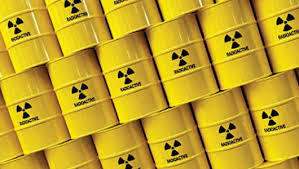Radioactive materials, such as the radioactive waste from power stations, can be danger to real heath and environmental hazard. So, it is essential that nuclear waste be kept in secure nuclear facilities with appropriate protection measures.
It is a fact that nuclear waste do not stay radioactive forever. Each radioactive material has hat is called half-life. This is a period after which it will have only half the activity it had before. After another half-life, the activity is down to a quarter. Eventually, the activity will reach safe levels. However, the whole process can sometimes take centuries. Till then, nuclear wastes remain a dangerous threat to both humanity and the planet.
It is a fact that nuclear waste do not stay radioactive forever. Each radioactive material has hat is called half-life. This is a period after which it will have only half the activity it had before. After another half-life, the activity is down to a quarter. Eventually, the activity will reach safe levels. However, the whole process can sometimes take centuries. Till then, nuclear wastes remain a dangerous threat to both humanity and the planet.






